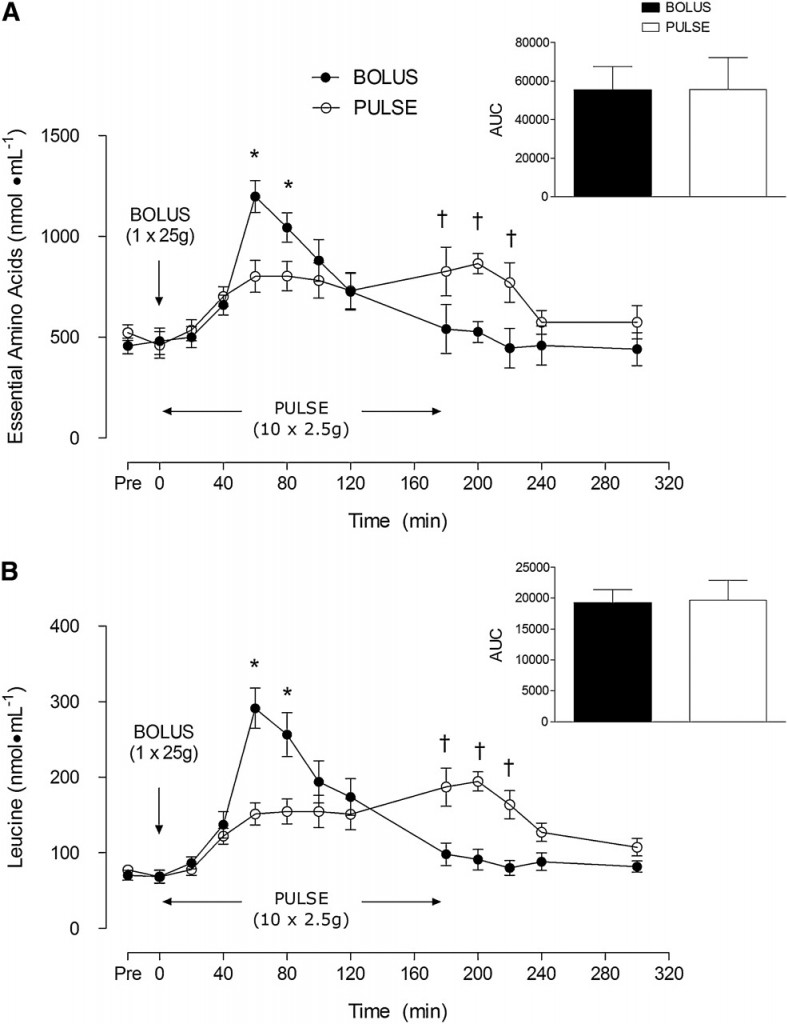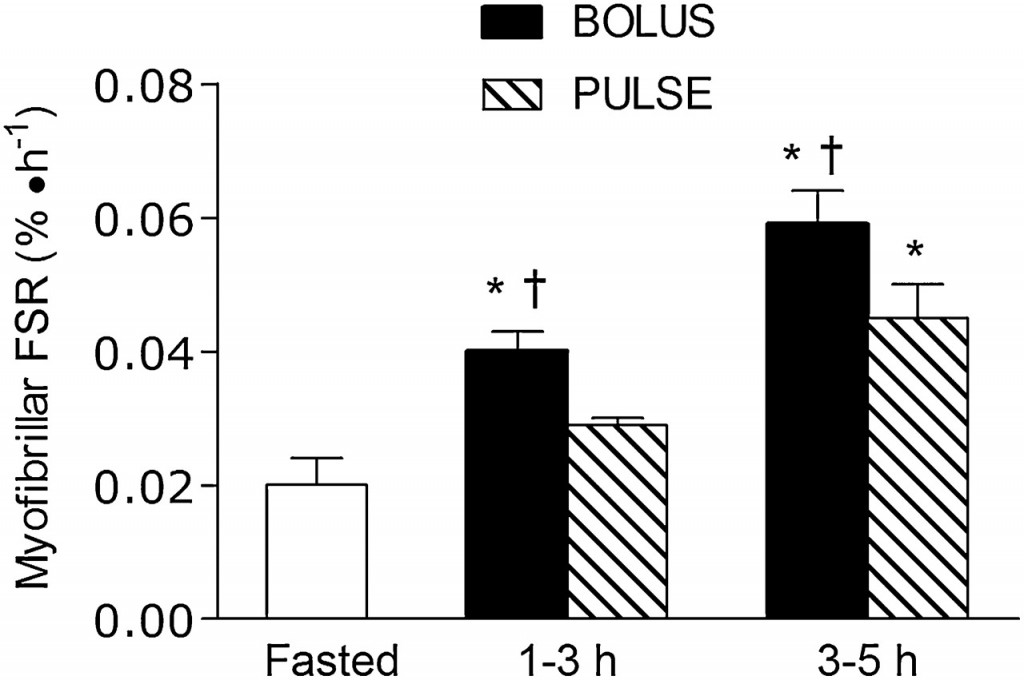Whey protein digests quickly while casein digests slowly. In this experiment, researchers tried to determine whether fast digestion or slow digestion is better for protein synthesis and muscle building. The conclusion? Fast digestion is best for boosting muscle protein synthesis.
Protein powder is a staple for anyone trying to put on muscle. I know that some of you PN Coaching guys looking to gain muscle have giant paint-can-sized tubs of protein powder as furniture in your apartments. (Good for you! Keep eating!)
If you walk into most supplement stores you’ll find more brands, flavors and types of protein than you can imagine. Of course, most people go with a powder that they can tolerate the taste of, since many brands taste remarkably bad (may we recommend a SuperShake instead?) However, which kind is best?
What is protein powder?
For starters, protein powder is simply processed, dried protein that’s convenient and portable. (For more on this, see All About Protein Powders.) These powders can be extracted from all sorts of different foods, including:
- dairy (whey and casein)
- egg (whole egg or egg white)
- soy
- hemp
- pea
- even beef
- etc.
In 2004, dairy-based proteins were the major source of protein in sports supplements — about three-quarters. Soy proteins made up most of the rest.[1] In recent years, plant based protein powders have become more common. However, dairy proteins like whey and casein still make up most of the protein supplements on the market.
Whey protein powder — the most common form of dairy-based protein powders — is the liquid by-product of making cheese. Casein, on the other hand, is from the solid part of skim milk when treated with acid (like lemon juice). Casein is what you get when milk curdles — it’s the curd part.
Dairy proteins (as well as egg protein) are considered complete proteins, since they have all essential amino acids in sufficient amounts. A few plant proteins, like hemp, are also complete, but have a lower total amount of protein.
Whey versus casein
Whey and casein have been a staple for bodybuilders for years. Each protein has unique characteristics. But which is better? Well, just like comparing an economy car and a sports car, deciding which protein is better depends on the purpose of the protein.
In terms of similarities, both are complete proteins and both have identical Protein Digestibility Corrected Amino Acid Scores (PCDAAs; 1.00) [2]. So, to determine which is better, we have to dig deeper.
In terms of differences, whey protein has more leucine, while casein is higher in glutamine (Figure 1). Whey is also absorbed much more quickly than casein.

Leucine and glutamine in muscle protein synthesis
Leucine, uniquely, activates skeletal muscle protein synthesis through a series of molecular biology interactions similar to dominos, called the mammalian target of rapamycin (mTOR) pathway. Since leucine is a key amino acid for activating protein synthesis, and since whey has more leucine, it’s a good choice for building muscle mass.
Glutamine is also important in muscle protein synthesis. After exercise, glutamine is depleted in blood plasma and muscle. More muscle glutamine is directly correlated to higher muscle protein synthesis. Glutamine supplementation leads to more growth hormone, which has anabolic affects on muscle.
Absorption rates
The other difference between whey protein and casein protein is how fast the protein is absorbed, and for how long.
Researchers measure blood amino acids to figure out rate of protein absorption. Drinking whey protein causes increases in blood amino acids levels in under an hour, with peak levels at just under 90 minutes. Casein takes longer to increase blood amino acids, but lasts longer, with elevated levels lasting over 300 minutes [3].
Table 1 – Whey vs glutamine: Summary
| Whey | Casein | |
|---|---|---|
| Complete protein | Yes | Yes |
| High in leucine | Yes | No |
| High in glutamine | No | Yes |
| Absorption rate | Fast | Slow |
| Duration of elevated blood amino acids | Short | Long |
Obviously, comparing whey and casein is complicated. You have different amino acids, different absorption and possibly different effects on the immune system.
How can you tell what really matters? One method is to keep all other conditions constant, then change one thing.
In this experiment, researchers used the same protein (constant), but adjusted how long it took for subjects to consume it (change one thing). Or as I like to call it, the chugging versus sipping experiment.
Research question
Today’s research question: Does rate of ingestion — and thus rate of absorption — change the effects of protein supplementation?
West DW, Burd NA, Coffey VG, Baker SK, Burke LM, Hawley JA, Moore DR, Stellingwerff T, Phillips SM. Rapid aminoacidemia enhances myofibrillar protein synthesis and anabolic intramuscular signaling responses after resistance exercise. Am J Clin Nutr. 2011 Sep;94(3):795-803. Epub 2011 Jul 27.
Methods
Eight moderately active young men drank 25 grams of whey protein following leg extension strength testing (10 rep max) on two occasions.
- Trial 1: The men chugged the entire 25 grams at once
- Trial 2: The men drank 2.5 grams 10 times over 200 minutes (every 20 minutes they took a shot of whey), which mimics the slow but long absorption of casein.
Blood amino acid concentration and blood leucine was measured from blood samples. Muscle protein synthesis (fractional synthesis rate; FSR) was measured through a biochemical technique called isotope labeling.
Researchers also measured amounts of specific proteins involved in regulating muscle protein synthesis from muscle biopsies. A biopsy needle the size of the barrel of a pen is used to sample muscle from the outer quadriceps (vastus lateralis).
Results
Either chugging or shooting a total of 25 grams of whey protein both increased essential amino acids and leucine in the blood (Figure 2a & b).
Chugging (bolus) caused a higher peak level of essential amino acids and leucine compared to serial shooting (pulse) but after 5 hours it seems everything evens out. As Figure 2 below shows, chugging and shooting had the same effect on overall levels, based on area under the curve (AUC), which is a way of looking at levels over a period of time rather than just the peak.

As interesting as blood leucine levels are, we really want to know what happens to protein synthesis in the muscle (aka myofibrillar protein synthesis). Figure 3 below shows the graph of protein synthesis. You can see that the drinking all the whey protein at once (bolus) increased protein synthesis more than spreading out the same amount of whey over 3 hours (pulse).

Conclusion
High peak levels of blood leucine and amino acids cause more muscle protein synthesis than blunted but longer elevated levels of blood leucine and amino acids. So what does that mean for you?
If muscle building is your primary goal, try drinking a fast-digesting protein drink (with at least 25 grams of protein) within 15 minutes of exercising. If you really want to experiment you could drink a second fast-digesting protein drink 2 or 3 hours after the first. It could be that a second drink after blood amino acids are back to normal would cause more muscle protein synthesis by causing a second peak in blood leucine.
[Of course, this study doesn’t directly suggest that casein or any other slow protein has no value. After all, casein wasn’t even used in this study. Rather, the researchers tried to mimic casein’s effects by slowing down the absorption of the whey protein. In fact, slow digestion may be an asset during other times of the day. However, after exercise, slow proteins might not be best.]
Now, if you can’t digest dairy, opt for lean proteins from whole foods, like eggs, seafood, or lean meats, and keep your post-workout fat intake low and carb intake high to speed absorption. Have some lean protein an hour or two before training as well, so that there are amino acids already starting to float around. If possible, eat your biggest protein meal of the day as soon as possible after heavy training. Even throw in some BCAA (branched chain amino acids) during training.
Bottom line
Drinking 25 grams of fast-digesting whey protein, all at once and immediately after exercise, increases muscle protein synthesis more than drinking 25 grams of whey protein over 3 hours after exercise.
References
Click here to view the information sources referenced in this article.
Eat, move, and live…better.©
The health and fitness world can sometimes be a confusing place. But it doesn't have to be.
Let us help you make sense of it all with this free special report.
In it you'll learn the best eating, exercise, and lifestyle strategies – unique and personal – for you.



Share